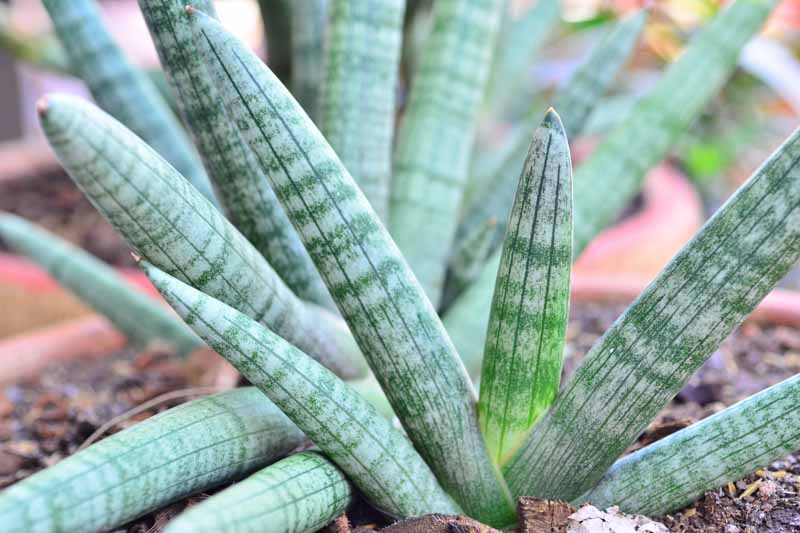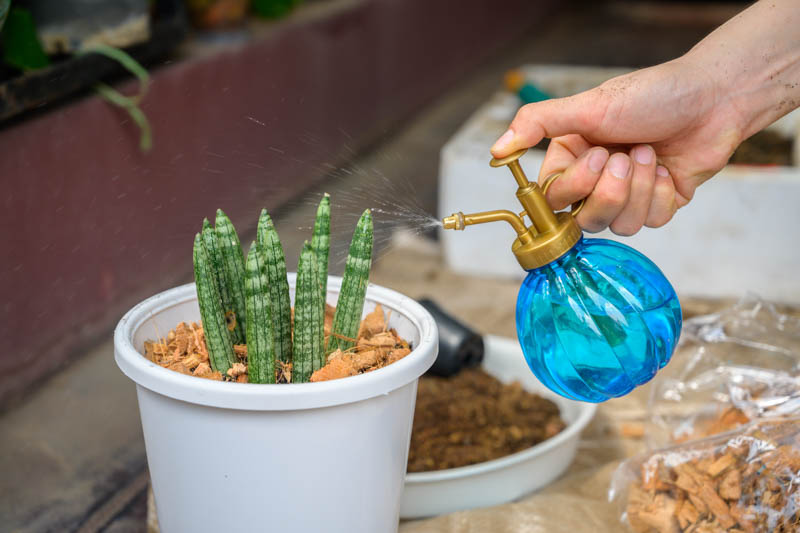African Spear, Brazil Saint Bárbara Sword, Cylindrical Snake Plant, Spear Sansevieria, Cylindrical Mother-in-Law's Tongue, Dracaena angolensis
Sansevieria cylindrica, also known as African Spear or Cylindrical Snake Plant is a unique plant, appreciated for its architectural form, resilience, and low maintenance needs, making it a favored choice for both novice and experienced gardeners.
Cylindrical Snake Plant or Sansevieria cylindrica boasts striking cylindrical leaves that grow vertically, reaching skyward like spears. The leaves are smooth and green and sometimes have a banded or mottled appearance. This slow-growing plant adds a modern touch to indoor and outdoor settings.
Native: This plant is native to Angola and other parts of tropical Africa, where it thrives in arid environments, showcasing its natural drought tolerance. It belongs to the asparagus family (Asparagaceae), along with agaves and hostas. Botanists recently reclassified Sansevieria to Dracaena.
Plant Type and Habit: Sansevieria cylindrica is an evergreen, rhizomatous perennial with a robust and upright growth habit. It’s known for its ability to grow both indoors and outdoors in suitable climates and adapts well to container life.
Size: It typically grows 4-6 feet tall (120-180 cm), with the leaves spreading out as the plant matures. The slow growth rate makes it an excellent plant for spaces that can’t accommodate rapid-growing species.
Flowers: Although rare, especially indoors, Sansevieria cylindrica can produce delicate, fragrant white or pale pink flowers on a spike-like inflorescence. Blooms typically appear in the late winter or early spring. Fruit production is rare, especially in cultivated settings. When it occurs, the plant produces small, orange berries.
Foliage: The cylindrical, spear-like leaves are the plant’s hallmark, offering an unusual texture and form compared to other houseplants. Leaves can also be braided or twisted for decorative purposes.
Hardiness: Sansevieria cylindrica is hardy in USDA zones 10-11, thriving outdoors in warm climates. It’s highly tolerant of indoor conditions, making it a popular houseplant worldwide.
Uses: It’s primarily used as an ornamental plant, ideal for adding structural interest to indoor spaces, patios, or gardens. Its air-purifying capabilities make it a beneficial addition to homes and offices.
Toxicity: The plant is toxic when ingested, causing nausea, vomiting, and diarrhea in pets and humans, so it should be kept away from children and animals.
Deer and Rabbits: Its toxicity and fibrous leaves generally deter deer and rabbits.
Drought: One of its key attributes is its exceptional drought tolerance. It requires minimal watering and can survive long periods without water.
Invasiveness: Sansevieria cylindrica is not considered invasive.

Growing and caring for Sansevieria cylindrica indoors is remarkably easy, making it ideal for both beginners and seasoned gardeners.
Light: While it can adapt to lower light conditions, Sansevieria cylindrica prefers bright, indirect sunlight. A spot near a window where sunlight is filtered through curtains is ideal. It can survive in lower light conditions, making it suitable for less sunny spaces, but growth may be slower.
Soil: Use a well-draining potting mix, ideally formulated for cacti or succulents, to prevent water from accumulating around the roots.
Water: Water sparingly, allowing the soil to dry completely between watering sessions. Overwatering is the most common issue and can lead to root rot. During the colder months, reduce watering frequency as the plant’s growth slows down.
Temperature and Humidity: Prefers average room temperatures between 60°F and 80°F (16°C to 27°C). Avoid exposure to temperatures below 55°F (13°C), as cold can damage the plant. It does well in average household humidity levels but can tolerate lower humidity without issue.
Fertilization: Fertilize with a balanced, water-soluble fertilizer diluted to half strength once or twice during the growing season (spring and summer). Do not fertilize in winter.
Pruning: Pruning is rarely needed except to remove any yellowed or damaged leaves. Use clean, sharp scissors or pruners to make any cuts.
Repotting: Sansevieria cylindrica prefers being slightly root-bound, so repotting is only necessary every 2-3 years or if you notice roots growing through the drainage holes. When repotting, choose a pot only slightly larger than the current one.
Caring for Sansevieria cylindrica outdoors requires an understanding of its native habitat to replicate conditions conducive to its growth.
Hardiness Zones: Sansevieria cylindrica is suited to USDA Hardiness Zones 10-11 for outdoor cultivation. It needs to be protected from frost and freezing temperatures, as it is not cold-hardy.
Light: It prefers bright, indirect light but can tolerate direct sunlight in the morning or late afternoon. In regions with intense sun, provide partial shade to prevent leaf scorching.
Soil: Ensure well-draining soil to prevent root rot. A mixture of potting soil with sand or perlite can improve drainage. When planting in the ground, choose a spot that doesn’t collect water. If using pots, ensure they have adequate drainage holes.
Water: Water sparingly, allowing the soil to dry completely between watering sessions. Overwatering is a common issue, especially outdoors, where it’s easier to overestimate the plant’s water needs. In rainy climates, consider growing it in a container that can be moved under cover during wet weather.
Fertilization: Feed with a half-strength, balanced fertilizer once or twice during the growing season. Do not fertilize in fall and winter when growth slows.
Pruning: Minimal pruning is required. Remove any yellow or damaged leaves to keep the plant looking its best.
Winter Care: In areas at the cooler end of its hardiness range or where temperatures dip below its tolerance level, provide protection. This could be mulching the base, using frost cloths, or bringing potted plants indoors.

Propagating Sansevieria cylindrica is a straightforward process that can be accomplished through several methods, including leaf cuttings and division. Here’s how to propagate this unique plant effectively:
Sansevieria cylindrica can sometimes encounter pests, diseases, and common problems.
Spider Mites: These tiny pests thrive in dry conditions, sucking sap from leaves, leading to yellowing and webbing. Increase humidity and wash plants with water; use miticides if necessary.
Mealybugs: Look for white, cottony masses on stems and undersides of leaves. Remove with alcohol-dipped cotton swabs or apply insecticidal soap.
Fungus gnat: These pests thrive in moist soil. Let the soil dry out between waterings, and use sticky traps or a diluted hydrogen peroxide solution to control their population.
Aphids: Small, pear-shaped pests that cluster on new growth and undersides of leaves, sucking plant sap and weakening it. They excrete sticky honeydew, attracting ants and promoting sooty mold growth.
Scale insects: Hard, dome-shaped pests that attach firmly to stems and leaves, feeding on sap. Their presence can lead to yellowing leaves, stunted growth, and a decline in plant health.
Root rot: Overwatering is the primary cause of root rot, which is a fungal issue. Prevent by ensuring well-draining soil and pots, and only water when the soil is dry.
Leaf spot: Caused by fungal or bacterial infections, resulting in discolored spots on leaves. Improve air circulation, reduce leaf wetness, and treat with fungicides if necessary.
Yellowing Leaves: Overwatering or poor drainage can lead to yellow leaves. Ensure the pot has adequate drainage holes and let the soil dry out between waterings.
Brown Tips or Edges: Low humidity, salt build-up from tap water, or over-fertilization can cause brown tips. Use distilled or rainwater for watering and fertilize sparingly.
Soft and Mushy Stems: A sign of overwatering or cold damage. Sansevieria cylindrica prefers warm environments and dry soil. Adjust watering habits and keep the plant in a warmer spot.
| Hardiness |
10 - 11 |
|---|---|
| Plant Type | Houseplants, Cactus & Succulents, Perennials |
| Plant Family | Asparagaceae |
| Genus | Dracaena |
| Common names | Snake Plant |
| Exposure | Partial Sun |
| Season of Interest |
Spring (Early, Mid, Late) Summer (Early, Mid, Late) Fall Winter |
| Height |
4' - 6' (120cm - 180cm) |
| Spread |
1' - 2' (30cm - 60cm) |
| Maintenance | Low |
| Water Needs | Low |
| Soil Type | Sand |
| Soil pH | Alkaline, Neutral |
| Soil Drainage | Well-Drained |
| Characteristics | Showy, Evergreen |
| Tolerance | Drought, Deer, Rabbit |
| Garden Uses | Patio And Containers |
| Hardiness |
10 - 11 |
|---|---|
| Plant Type | Houseplants, Cactus & Succulents, Perennials |
| Plant Family | Asparagaceae |
| Genus | Dracaena |
| Common names | Snake Plant |
| Exposure | Partial Sun |
| Season of Interest |
Spring (Early, Mid, Late) Summer (Early, Mid, Late) Fall Winter |
| Height |
4' - 6' (120cm - 180cm) |
| Spread |
1' - 2' (30cm - 60cm) |
| Maintenance | Low |
| Water Needs | Low |
| Soil Type | Sand |
| Soil pH | Alkaline, Neutral |
| Soil Drainage | Well-Drained |
| Characteristics | Showy, Evergreen |
| Tolerance | Drought, Deer, Rabbit |
| Garden Uses | Patio And Containers |
How many Sansevieria cylindrica (Snake Plant) do I need for my garden?
| Plant | Quantity | |
|---|---|---|
| Sansevieria cylindrica (Snake Plant) | N/A | Buy Plants |
Create a membership account to save your garden designs and to view them on any device.
Becoming a contributing member of Gardenia is easy and can be done in just a few minutes. If you provide us with your name, email address and the payment of a modest $25 annual membership fee, you will become a full member, enabling you to design and save up to 25 of your garden design ideas.
Join now and start creating your dream garden!
Create a membership account to save your garden designs and to view them on any device.
Becoming a contributing member of Gardenia is easy and can be done in just a few minutes. If you provide us with your name, email address and the payment of a modest $25 annual membership fee, you will become a full member, enabling you to design and save up to 25 of your garden design ideas.
Join now and start creating your dream garden!